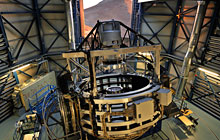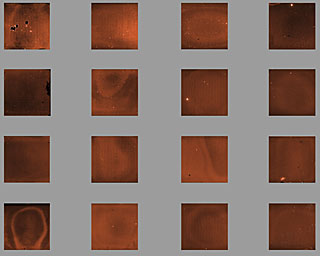VIRCAM
VISTA InfraRed CAMera
The 4.1-metre Visible and Infrared Survey Telescope for Astronomy (VISTA) opens up a unique window into our galactic surroundings with help from the VISTA InfraRed CAMera (VIRCAM) as it surveys the night sky. This telescope certainly lives up to its name — what a view VISTA gives us of the Universe! Located on its own peak, and offering a stunning panorama that includes the Very Large Telescope (VLT) platform, VIRCAM and VISTA are the vision of a consortium of 18 UK universities, and is watched over by Boris Haeussler and Juan Carlos Muñoz at ESO-Chile.
VISTA is a survey telescope, which means that its main purpose is to map large areas of the sky and to do so quickly. “Together, VIRCAM and VISTA are able to cover an area nearly eight times the size of the moon,” says Oscar González, instrument specialist. By utilising 16 special detectors equating to some 67 million pixels, VISTA has embarked on six complementary surveys covering many aspects of astronomy; from our own galaxy, the Milky Way, to its satellites — the Small and Large Magellanic Clouds — all the way out to deep extragalactic space. As a result huge amounts of data are generated each night: 315 GB on average, which is equivalent to 13 high definition Blu-ray discs! VIRCAM not only does this very well, but it does so in the infrared. To avoid swamping the faint infrared radiation coming from space, the camera has to be cooled to -200 degrees Celsius and is sealed with the largest infrared-transparent window ever made.
 “Have you ever had the chance to take a detailed look at a starry night?” asks Oscar. “If you follow the majestic blanket of stars that traces the Milky Way, a large dark patch in the middle of it will immediately catch your eyes. This dark patch is in the middle of the Milky Way and is also the place with the highest density of stars! However, our eyes are not able to see those stars due to the large amount of dust located between them and us.” To overcome this, VIRCAM and VISTA work together to search for the infrared light from those stars — light that is able to overcome this dust barrier to reach us. This is why we can observe other dusty places using the 3-tonne heavy VIRCAM, such as the areas where stars are born and the central regions of other galaxies similar to our own.
“Have you ever had the chance to take a detailed look at a starry night?” asks Oscar. “If you follow the majestic blanket of stars that traces the Milky Way, a large dark patch in the middle of it will immediately catch your eyes. This dark patch is in the middle of the Milky Way and is also the place with the highest density of stars! However, our eyes are not able to see those stars due to the large amount of dust located between them and us.” To overcome this, VIRCAM and VISTA work together to search for the infrared light from those stars — light that is able to overcome this dust barrier to reach us. This is why we can observe other dusty places using the 3-tonne heavy VIRCAM, such as the areas where stars are born and the central regions of other galaxies similar to our own.
Different objects in the Universe can also have a variety of temperatures. Cold sources, such as brown dwarfs (“failed” stars that are too small to sustain nuclear fusion), are extremely faint in the visible wavelengths, but brighter in the infrared, which allows them to be detected by VIRCAM. VIRCAM also helps us to see some of the most distant astronomical objects, such as quasars and galaxies from when our Universe was very young, as the wavelength of the light from these objects has been stretched into the infrared by the expansion of the Universe during the light’s long journey to us.
“These unique capabilities of VIRCAM are powered by the large aperture of the VISTA,” explains Oscar. “Combined with the large field of view and high sensitivity in the infrared regime, this makes VISTA the world's most efficient survey telescope.”
Science highlights with VIRCAM
- ESO Telescopes (including VISTA with VIRCAM) observe first light from gravitational wave source (eso1733)
- Remains of archaic globular star cluster found at the centre of the Milky Way (eso1636)
- VISTA pinpoints earliest giant galaxies (eso1545)
- The peanut at the heart of the Milky Way: a 3D map of the centre of our galaxy, created with VIRCAM data, revealed the shape of our galaxy’s bulge. (eso1339)
- VISTA catalogues 84 million stars in the centre of the Milky Way. (eso1242)
- VIRCAM makes invisible parts of the Helix nebula visible again! (eso1205)
- List of the scientific papers produced by VIRCAM , via the ESO library TelBib database.
|
Although it is hard to believe, this raw image, straight from the instrument, was used together with many others to produce the beautiful photo of the Orion Nebula further up this page. VIRCAM includes 16 independent infrared detectors. Because of technical constraints, these detectors cannot be installed next to each other, resulting in large gaps between them. In order to obtain a full coverage of the field of view, a series of images is taken, moving the telescope between each exposure. All the images are then combined. The images taken with astronomical instruments are always monochromatic: the information on the colour is is obtained by taking exposures through different coloured glass filters. |
VIRCAMThe authoritative technical specifications as offered for astronomical observations are available from the Science Operation page.
|


